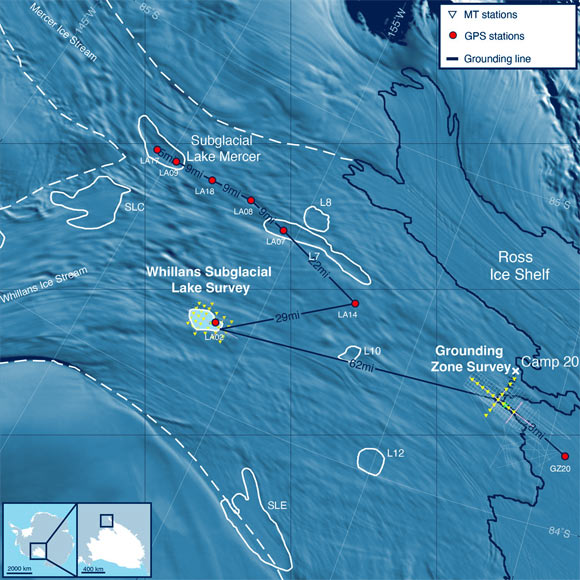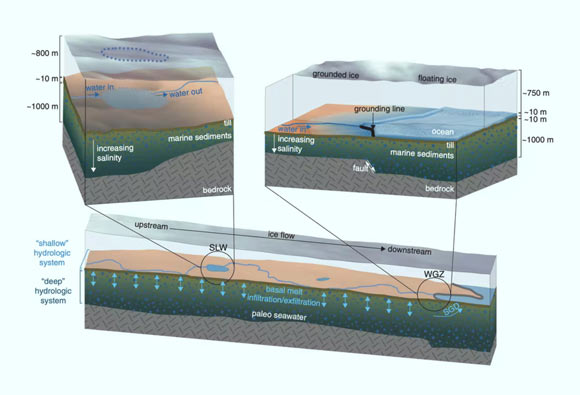According to new research published in the journal Science, subglacial sediments beneath Whillans Ice Stream in West Antarctica are saturated with a mixture of ancient seawater and freshwater from a glacier; this groundwater, extending downward for more than 1 km, contains more than 10 times as much volume as the shallow hydrologic system above and actively exchanges with it.

Survey locations on the Whillans Ice Stream in West Antarctica: electromagnetic imaging stations were set up in two general areas (yellow markings); the researchers traveled to wider areas to perform other tasks, shown by red dots. Image credit: Gustafson et al., doi: 10.1126/science.abm3301.
Subglacial water moves along the base of the Antarctic Ice Sheet through an under-ice plumbing network known as the subglacial hydrologic system.
Water flow in this system plays an important role in modulating ice motion by providing lubrication between the ice sheet and the bedrock, or by causing the deformation of wet sediments beneath glaciers.
Through these two mechanisms, water at the base of the ice sheet controls Antarctica’s ice sheet dynamics and, potentially, its contribution to sea level rise.
To date, the subglacial hydrologic system has been considered to be a shallow system in which water exists either at or very near the base of the ice sheet.
“It’s been a hypothesis from our understanding of how the planet works that there’s groundwater under Antarctica, but we haven’t been able to measure it before,” said Dr. Helen Amanda Fricker, a glaciologist with the Institute of Geophysics and Planetary Physics at the Scripps Institution of Oceanography at the University of California, San Diego, and co-director of the Scripps Polar Center.

Illustrations of the Whillans Ice Stream in West Antarctica show liquid water under the ice from subglacial lakes (left) and groundwater within the sediment; the ice stream moves at about 300 m per year. Image credit: Gustafson et al., doi: 10.1126/science.abm3301.
In their research, Dr. Fricker and her colleagues used magnetotelluric and passive seismic data from Whillans Ice Stream, West Antarctica, to provide the first observations of deep sub-ice stream groundwater.
They found that the subglacial sediments beneath Whillans Ice Stream are saturated with a mixture of fossil seawater and freshwater from the glacier.
This groundwater, extending downward for more than 1 km, contains more than ten times as much fluid volume as the shallow hydrologic system above and actively exchanges with it.
Consequently, it has the potential to modulate ice streaming and subglacial biogeochemical reactions.
“People have hypothesized that there could be deep groundwater in these sediments, but up to now, no one has done any detailed imaging,” said Chloe Gustafson, a researcher with the Lamont-Doherty Earth Observatory at Columbia University.
“The amount of groundwater we found was so significant, it likely influences ice-stream processes.”
“Now we have to find out more and figure out how to incorporate that into models.”
_____
Chloe D. Gustafson et al. 2022. A dynamic saline groundwater system mapped beneath an Antarctic ice stream. Science 376 (6593): 640-644; doi: 10.1126/science.abm3301







